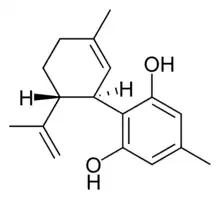Cannabidiorcol
 | |
| Identifiers | |
|---|---|
IUPAC name
| |
| CAS Number | |
| PubChem CID | |
| ChemSpider | |
| UNII | |
| Chemical and physical data | |
| Formula | C17H22O2 |
| Molar mass | 258.361 g·mol−1 |
| 3D model (JSmol) | |
SMILES
| |
InChI
| |
Cannabidiorcol (CBDO, CBD-C1, O-1821) is a phytocannabinoid found naturally in Cannabis in trace concentrations. It is related to cannabidiol, with the pentyl side chain shortened to a methyl group. Cannabidiorcol has low affinity for cannabinoid receptors and is mainly active as an agonist of the TRPV2 cation channel, through which it produces antiinflammatory effects,[1] but can also promote tumorigenesis at high concentrations.[2]
See also
References
- ↑ Laragione T, Harris C, Gulko PS (March 2023). "Combination therapy of a TRPV2 agonist with a TNF inhibitor achieves sustained suppression of disease severity and reduced joint damage". Clinical and Experimental Immunology. 211 (3): 233–238. doi:10.1093/cei/uxac124. PMC 10038320. PMID 36571199.
- ↑ Huang R, Li S, Tian C, Zhou P, Zhao H, Xie W, et al. (November 2022). "Thermal stress involved in TRPV2 promotes tumorigenesis through the pathways of HSP70/27 and PI3K/Akt/mTOR in esophageal squamous cell carcinoma". British Journal of Cancer. 127 (8): 1424–1439. doi:10.1038/s41416-022-01896-2. PMC 9553907. PMID 35896815.
| Phytocannabinoids (comparison) |
| ||||||||||||||||||||||||||||||||||||||||||||||||||
|---|---|---|---|---|---|---|---|---|---|---|---|---|---|---|---|---|---|---|---|---|---|---|---|---|---|---|---|---|---|---|---|---|---|---|---|---|---|---|---|---|---|---|---|---|---|---|---|---|---|---|---|
| Endocannabinoids |
| ||||||||||||||||||||||||||||||||||||||||||||||||||
| Synthetic cannabinoid receptor agonists / neocannabinoids |
| ||||||||||||||||||||||||||||||||||||||||||||||||||
| Allosteric CBRTooltip Cannabinoid receptor ligands | |||||||||||||||||||||||||||||||||||||||||||||||||||
| Endocannabinoid enhancers (inactivation inhibitors) |
| ||||||||||||||||||||||||||||||||||||||||||||||||||
| Anticannabinoids (antagonists/inverse agonists/antibodies) |
| ||||||||||||||||||||||||||||||||||||||||||||||||||
| |||||||||||||||||||||||||||||||||||||||||||||||||||
| Receptor (ligands) |
| ||||||||||||
|---|---|---|---|---|---|---|---|---|---|---|---|---|---|
| Transporter (modulators) |
| ||||||||||||
| Enzyme (modulators) |
| ||||||||||||
| Others |
| ||||||||||||
| |||||||||||||
This article is issued from Offline. The text is licensed under Creative Commons - Attribution - Sharealike. Additional terms may apply for the media files.